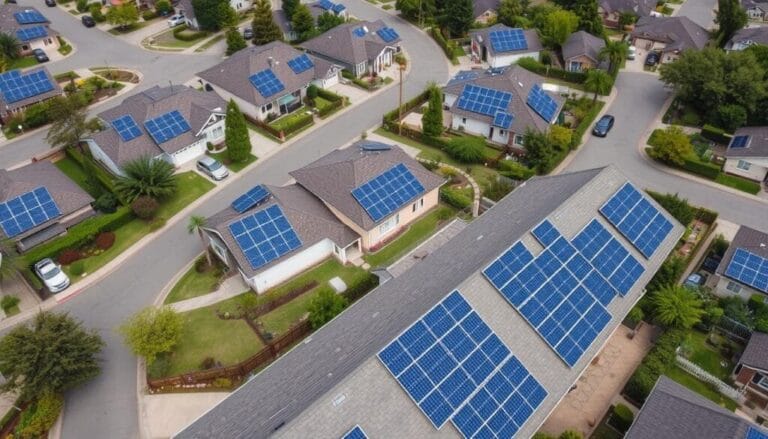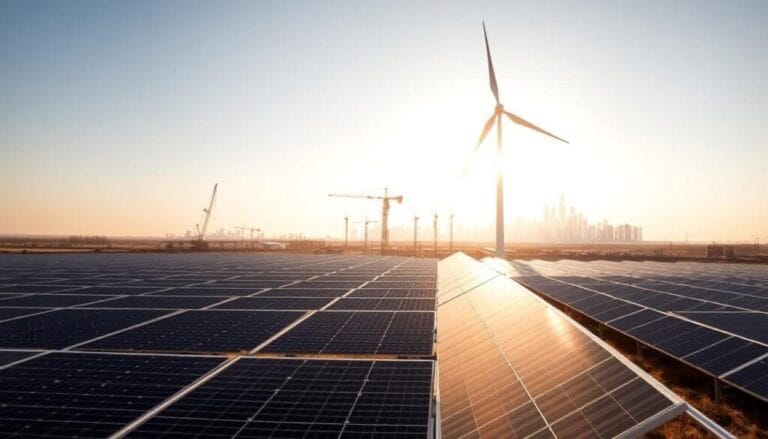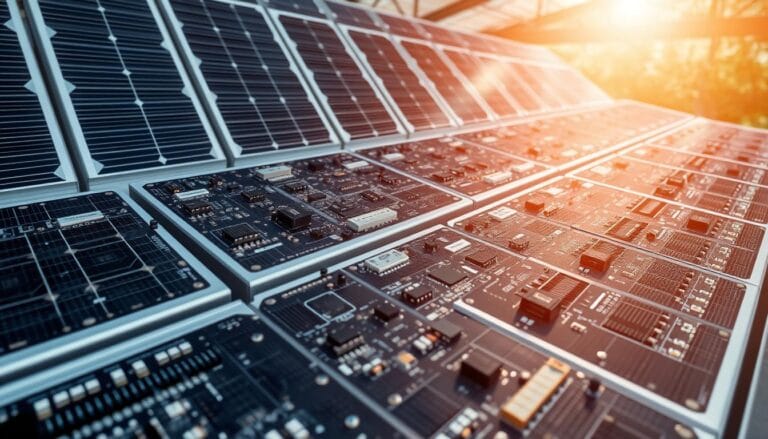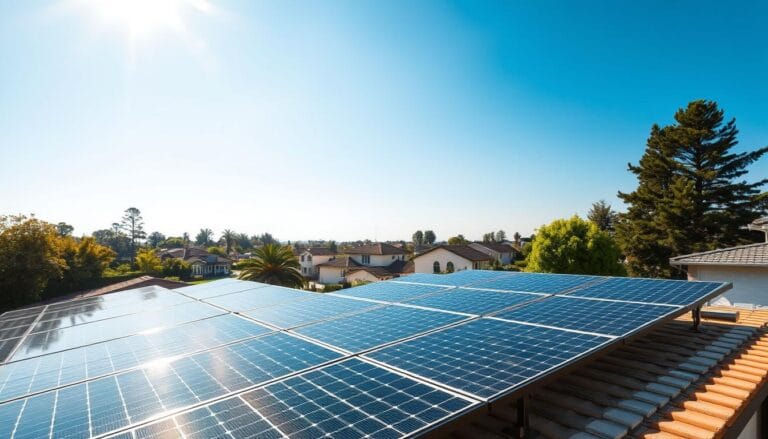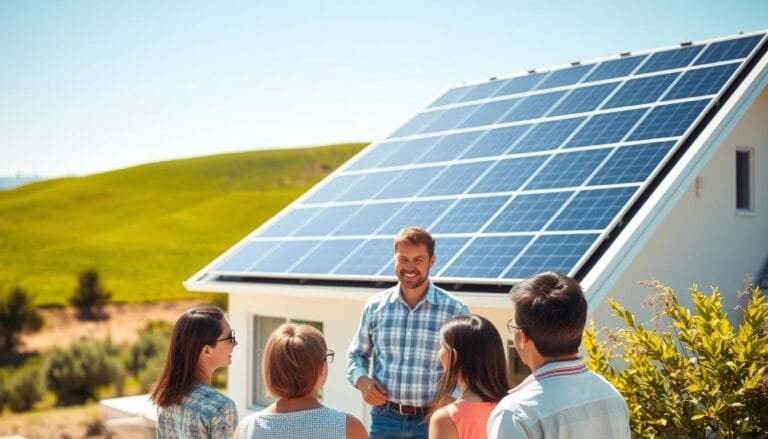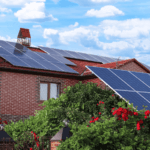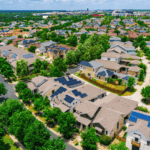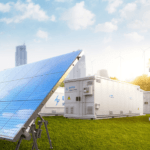Going solar is now a smart money move for homeowners in the U.S. Electricity costs are going up, and solar panel prices are coming down. It’s key to know how to calculate solar energy savings. Solar energy is not just good for the planet; it can also save you a lot of money over the next 30 years.
Homeowners can expect to see a drop in the cost of solar panels. This makes solar a smart investment that could save you thousands. With rebates and tax credits, the upfront cost of solar panels goes down. Using solar savings calculators, you can see how much you could save, potentially over $100,000, based on your electricity rates and solar setup.
Key Takeaways
- Investing in solar power can lead to financial savings with solar energy, significantly cutting electricity bills.
- Initial solar panel installation costs are offset by long-term savings, with average estimates ranging from $25,500 to $33,890 over the system’s life.
- With a federal tax credit of 30% and additional state incentives, solar investments become increasingly cost-effective.
- The break-even point for solar investments can be as soon as five years, with potential savings upwards of $50,000 over 25 years.
- Local electricity rates, solar panel efficiency, and net metering policies are critical factors in determining the extent of solar energy savings.
- The typical U.S. household’s potential reduction in energy costs can encourage a broad adoption of solar panels.
- Solar panels not only promise financial relief but also contribute to significant environmental benefits by offsetting carbon emissions.
Understanding the Cost of Solar Energy Installation
Starting with solar panels means looking at the costs. This part talks about the first costs, how prices change by state, and savings from government incentives.
The Initial Investment in Solar Panels
The cost to get solar panels varies a lot. By mid-2023, the average cost for a home system was about $31,558 for an 8.6 kW setup. Prices change based on the system’s size and tech, but they usually range from $8,500 to over $30,000. It’s important for homeowners to know this cost if they’re thinking about switching to cost-effective solar energy solutions.
State-by-State Installation Costs for Solar Systems
Solar system costs change a lot by state. This is because of differences in labor, fees, and equipment. For example, places like California and Arizona might be cheaper because they get more sun and have a competitive market. But, places with less solar use might cost more.
Available Rebates and Federal Tax Credits
Government policies help make solar panels cheaper and easier to get. The solar energy tax incentives, like the federal tax credit, cut the cost by 30%. This makes solar more affordable for many families. Plus, state-specific incentives can lower the upfront cost even more. For example, the Database of State Incentives for Renewables & Efficiency (DSIRE) lists many local incentives that can help with solar panel cost savings.
| Factor | Impact on Cost |
|---|---|
| System Size | Directly correlates with initial cost |
| Location | Varies due to labor, permits, and equipment |
| Federal Tax Credit | Reduces system cost by 30% |
| State Incentives | Can further lower costs |
When thinking about solar, knowing these costs and savings is key. With solar tech getting better and more affordable, now is a great time to look into it. It could save you money and help the environment.
Analyzing Solar Energy Cost Savings
Looking into solar panels shows that more than just panel quality and sunlight matters. The solar energy return on investment depends on many economic and policy factors. Scientific studies help us understand these savings better.
A solar panel roi calculator is useful for homeowners to see potential savings over time. This is important when thinking about the cost to install them. For example, the MarketWatch guide on solar savings shows how local electricity rates and usage affect savings.
To really understand calculate solar panel savings, you need to know the local energy market well. The National Renewable Energy Laboratory (NREL) has done important research on this. Their work helps homeowners see how fast solar energy can pay off.
Studies show big benefits in solar energy cost comparison, especially with state and federal incentives like tax credits. These incentives can make solar panels pay off faster. The Lawrence Berkeley National Laboratory (LBNL) found most solar setups in the U.S. start saving money in about six years.
Tools for solar energy cost comparison look at many things, like how fast solar is installed and government policies. These tools help property owners see when and where solar is a good investment.
| Cost Element | Before Solar Installation | After Solar Installation |
|---|---|---|
| Monthly Electricity Bill | $118 | $30 |
| Cumulative Savings Over 20 years | 0 | $40,000 |
| Initial Investment | $17,400 – $23,900 | |
The 30% tax credit from the Residential Clean Energy Credits program helps make solar panels more affordable. Experts at Solar Powers World, a top solar solution provider, agree. They were reviewed by CEO & CTO Forhad Khan.
Choosing solar technology can be a smart move when you look at the returns and payback times. This shows solar energy is a good investment compared to traditional energy sources.
How much money can I save with solar energy?
Looking into calculate solar energy savings means checking out your energy use, local rates, and how much power your system can make. If you match a solar system to your yearly energy use—about 10,500 kWh for U.S. homes—you could save a lot. Using a solar panel savings estimator, we can see how much money you might save over time.
Money saved with solar power depends on how much electricity costs in your area and how much solar energy you produce. In places with lots of sun, homeowners might save up to $90,000 over 25 years. In sunny spots like California, savings could be even higher because of high electricity prices and good state incentives.
To calculate solar savings well, think about what it costs to install the system and how much you’ll save over time. A 6 kW system usually costs about $18,000, but with a 30% federal tax credit, it’s closer to $12,600. This can pay off in 6 to 10 years.
Looking into the solar energy savings potential, different places have different results. For example, San Diego, being very sunny, estimates savings at $95,412 over 25 years for a 6 kW system. Looking into the benefits of solar energy shows how it helps the environment and your wallet in various places.
| City | Estimated 25-Year Savings |
|---|---|
| Phoenix, AZ | $40,977 |
| Fresno, CA | $66,565 |
| San Diego, CA | $95,412 |
To really understand how to calculate solar savings, you need to look closely at local factors. This analysis should include local electricity prices and the quality of solar panels. These things are key to figuring out the cost of going solar.
Finally, solar energy cost savings analysis is crucial for homeowners thinking about solar power. Using solar panels cuts costs for decades and helps the planet by using less traditional energy.
Maximizing Your Financial Returns with Solar Energy
To get the most out of solar energy, it’s key to know the best strategies and financial plans. Using efficient solar panels and setting the right financial goals can greatly increase your solar investment’s returns.
Strategies to Maximize Solar Panel Efficiency
Start by making your solar panels work better. Choose top-quality panels that fit your local weather and position them to catch the most sun. Keeping panels clean helps them work well over time. Using smart tech can also help manage energy use, making your solar panels more efficient.
Calculating the Break-Even Point for Solar Investments
Knowing when your solar panels will pay for themselves is important. This is done by dividing the total cost by the yearly savings on electricity bills. With local solar perks and state solar policies, most people see payback in 7 to 10 years. After that, all the energy made is free, making solar a smart choice.
Looking into net metering and SREC markets can also boost your solar earnings. New programs like New York State’s VDER Value Stack offer better ways to get paid for your solar power.
Getting the most from solar energy comes from investing in tech, getting government support, and planning your finances well. By using these methods, homeowners can make a smart move to solar that saves money and helps the planet.
Factors Influencing Solar Energy Savings
Many things affect how much money homeowners can save with solar panels. These factors deeply impact the financial benefits of using solar energy. Knowing these can help you save more money.
The Impact of Local Electricity Rates on Solar Savings
Electricity rates where you live are key to how much you can save with solar power. In places with high electricity prices, switching to solar can save a lot of money. Each kilowatt-hour of solar energy can offset a higher cost.
In areas with lower utility rates, the savings might not be as big. But, they are still worth it in the long run, especially as energy prices go up.
Understanding Net Metering and its Benefits
Net metering is a big deal for solar energy savings. It lets homeowners lower their bills by sending extra energy back to the grid. This system uses the grid as a battery, storing extra power for later use.
Net metering boosts savings by letting homeowners use the grid as a battery. This is especially true in sunny places where solar panels work best. For more details, check out energy studies on the long-term benefits.
The size of your solar panel system matters too. If it’s too big or too small, it won’t work well or save you money. Make sure your system matches your energy use all year.
| Factor | Impact | Typical Savings |
|---|---|---|
| Utility Rates | Higher rates equate to greater savings | Up to 80% reduction in bills |
| Net Metering | Compensates for excess power generated | Significant reduction or even credit |
| System Size | Needs to match home energy use | Optimal use can cover 100% of home’s energy needs |
Also, new solar panel technology can help save even more money. With better modules and storage options, solar power is becoming a smarter choice every year. Check out solar technology advancements for more info.
Conclusion
Homeowners can greatly save money with solar power. The average American household spends about $1,430 a year on electricity. With typical use at 11,000 kilowatt-hours, solar energy offers big savings.
The national average electricity rate is $0.1301 per kWh. This makes solar power a smart choice. By using solar energy savings incentives, like the federal tax credit, homeowners can save even more. This tax credit cuts off 26% of the installation costs.
States like Arizona, California, and New York show big savings over time. These savings make the initial cost of solar systems worth it. With solar technology getting better, systems can now turn up to 22% of available energy into electrical power.
This means homeowners can save a lot on their electricity bills. Sometimes, costs can be cut by 50-100% over the system’s life. With these benefits, solar power is a wise choice for homeowners. It helps save money and supports a clean energy future.
FAQ
How much can I expect to save on my energy bill with solar panels?
How much can I expect to save on my energy bill with solar panels?
FAQ
How much can I expect to save on my energy bill with solar panels?
Solar panels can save you up to
FAQ
How much can I expect to save on my energy bill with solar panels?
Solar panels can save you up to $1,500 a year on your energy bills. Over 25 to 30 years, this could add up to $25,500 to $33,000 in savings. This depends on your local electricity rates and how much energy your home uses.
What is the initial investment for installing a solar panel system?
Solar panel installation costs range from $8,500 to $30,500. A typical 6-kW system costs between $14,600 and $21,700. But, federal and state incentives can cut this cost down a lot.
Are there state-specific costs or incentives I should be aware of?
Yes, costs and incentives for solar panels vary by state. Check the Database of State Incentives for Renewables & Efficiency (DSIRE) to see what you might get in your state.
How does the Federal Tax Credit affect the cost of solar energy installation?
The Federal Tax Credit, or Investment Tax Credit (ITC), lets homeowners deduct up to 30% of their solar system’s cost from their taxes. This can greatly reduce what you pay upfront.
What factors affect the return on investment for solar energy?
Several things affect solar energy’s ROI. These include installation costs, electricity rates, how much energy your home uses, and your solar panels’ efficiency. Net metering and tax incentives can also improve your returns.
How do I calculate my solar panel savings?
Use a solar panel savings estimator or calculator to figure out your savings. You’ll need to know your average electricity bill, local energy rates, your solar system’s size, and its efficiency. Don’t forget to consider net metering and tax incentives for a better estimate.
What strategies can be employed to maximize solar panel efficiency?
For better solar panel efficiency, pick high-quality panels for your climate and position them right. Keep them clean and well-maintained. Choosing the right system size for your energy needs is also key.
How do I calculate the break-even point for my solar investment?
To find your solar investment’s break-even point, divide the system’s net cost (after rebates and incentives) by your yearly savings from solar panels. This tells you how many years it’ll take for savings to cover the system’s cost.
How do local electricity rates impact solar energy savings?
Local electricity rates affect your solar savings a lot. Higher rates mean bigger savings, since you’re offsetting more expensive grid electricity with solar power.
What is net metering and how does it benefit solar panel owners?
Net metering lets solar panel owners sell extra electricity back to the grid for credits on their bills. This can lower your monthly energy costs and increase your savings over time.
,500 a year on your energy bills. Over 25 to 30 years, this could add up to ,500 to ,000 in savings. This depends on your local electricity rates and how much energy your home uses.
What is the initial investment for installing a solar panel system?
Solar panel installation costs range from ,500 to ,500. A typical 6-kW system costs between ,600 and ,700. But, federal and state incentives can cut this cost down a lot.
Are there state-specific costs or incentives I should be aware of?
Yes, costs and incentives for solar panels vary by state. Check the Database of State Incentives for Renewables & Efficiency (DSIRE) to see what you might get in your state.
How does the Federal Tax Credit affect the cost of solar energy installation?
The Federal Tax Credit, or Investment Tax Credit (ITC), lets homeowners deduct up to 30% of their solar system’s cost from their taxes. This can greatly reduce what you pay upfront.
What factors affect the return on investment for solar energy?
Several things affect solar energy’s ROI. These include installation costs, electricity rates, how much energy your home uses, and your solar panels’ efficiency. Net metering and tax incentives can also improve your returns.
How do I calculate my solar panel savings?
Use a solar panel savings estimator or calculator to figure out your savings. You’ll need to know your average electricity bill, local energy rates, your solar system’s size, and its efficiency. Don’t forget to consider net metering and tax incentives for a better estimate.
What strategies can be employed to maximize solar panel efficiency?
For better solar panel efficiency, pick high-quality panels for your climate and position them right. Keep them clean and well-maintained. Choosing the right system size for your energy needs is also key.
How do I calculate the break-even point for my solar investment?
To find your solar investment’s break-even point, divide the system’s net cost (after rebates and incentives) by your yearly savings from solar panels. This tells you how many years it’ll take for savings to cover the system’s cost.
How do local electricity rates impact solar energy savings?
Local electricity rates affect your solar savings a lot. Higher rates mean bigger savings, since you’re offsetting more expensive grid electricity with solar power.
What is net metering and how does it benefit solar panel owners?
Net metering lets solar panel owners sell extra electricity back to the grid for credits on their bills. This can lower your monthly energy costs and increase your savings over time.






